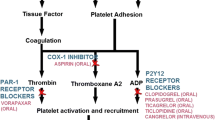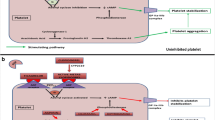Abstract
Despite recent advances in the acute treatment of stroke, prevention and risk factor modification remain the mainstays of management for patients with ischemic stroke and transient ischemic attack. The majority of noncardioembolic ischemic strokes are atherothrombotic, presumed to be associated with the activation and aggregation of platelets. Antiplatelet medications have been shown to be effective in the secondary prevention of stroke of presumed arterial origin, both as monotherapy and in combination. Among combination of antiplatelet agents, aspirin plus extended-release dipyridamole has demonstrated statistically significant additive benefit over monotherapy with each agent. Clopidogrel plus aspirin does not prevent recurrent ischemic stroke over each component individually, and the combination increases the risk of hemorrhagic side effects. This article reviews the most recent studies on antiplatelet medications, including the combination of aspirin and clopidogrel or extended-release dipyridamole, and discusses some of the controversies that still exist with the use of antiplatelet agents.
Similar content being viewed by others
References and Recommended Reading
Rosamond W, Flegal K, Friday G, et al.: Heart disease and stroke statistics—2007 update: a report from the American Heart Association Statistics Committee and Stroke Statistics Subcommittee. Circulation 2007, 115:e69–e171.
Bellavance A: Efficacy of ticlopidine and aspirin for prevention of reversible cerebrovascular ischemic events. The Ticlopidine Aspirin Stroke Study. Stroke 1993, 24:1452–1457.
Gorelick PB, Richardson D, Kelly M, et al.: Aspirin and ticlopidine for prevention of recurrent stroke in black patients: a randomized trial. JAMA 2003, 289:2947–2957.
Ticlopidine Aspirin Stroke Study Group: Ticlopidine versus aspirin for stroke prevention: on-treatment results from the ticlopidine aspirin stroke study. J Stroke Cerebrovasc Dis 1993, 3:168–176.
Bennett CL, Weinberg PD, Rozenberg-Ben-Dror K, et al.: Thrombotic thrombocytopenic purpura associated with ticlopidine. A review of 60 cases. Ann Intern Med 1998, 128:541–544.
Culebras A, Rotta-Escalante R, Vila J, et al.: Triflusal vs aspirin for prevention of cerebral infarction: a randomized stroke study. Neurology 2004, 62:1073–1080.
Murdoch D, Plosker GL: Triflusal: a review of its use in cerebral infarction and myocardial infarction, and as thromboprophylaxis in atrial fibrillation. Drugs 2006, 66:671–692.
Matías-Guiu J, Ferro JM, Alvarez-Sabín J, et al.: Comparison of triflusal and aspirin for prevention of vascular events in patients after cerebral infarction: the TACIP Study: a randomized, double-blind, multicenter trial. Stroke 2003, 34:840–848.
Matsumoto M: Cilostazol in secondary prevention of stroke: impact of the Cilostazol Stroke Prevention Study. Atheroscler Suppl 2005, 6:33–40.
Uchiyama S, Ozaki Y, Satoh K, et al.: Effect of sarpogrelate, a 5-HT(2A) antagonist, on platelet aggregation in patients with ischemic stroke: clinical-pharmacological dose-response study. Cerebrovasc Dis 2007, 24:264–270.
Diener HC, Cunha L, Forbes C, et al.: European Stroke Prevention Study. 2. Dipyridamole and acetylsalicylic acid in the secondary prevention of stroke. J Neurol Sci 1996, 143:1–13.
A randomised, blinded, trial of clopidogrel versus aspirin in patients at risk of ischaemic events (CAPRIE). CAPRIE Steering Committee [no authors listed]. Lancet 1996, 348:1329–1339.
Markus HS, Droste DW, Kaps M, et al.: Dual antiplatelet therapy with clopidogrel and aspirin in symptomatic carotid stenosis evaluated using Doppler embolic signal detection: the Clopidogrel and Aspirin for Reduction of Emboli in Symptomatic Carotid Stenosis (CARESS) trial. Circulation 2005, 111:2233–2240.
Diener HC, Bogousslavsky J, Brass LM, et al.: Aspirin and clopidogrel compared with clopidogrel alone after recent ischaemic stroke or transient ischaemic attack in high-risk patients (MATCH): randomised, double-blind, placebo-controlled trial. Lancet 2004, 364:331–337.
Bhatt DL, Topol EJ: Clopidogrel added to aspirin versus aspirin alone in secondary prevention and high-risk primary prevention: rationale and design of the Clopidogrel for High Atherothrombotic Risk and Ischemic Stabilization, Management, and Avoidance (CHARISMA) trial. Am Heart J 2004, 148:263–268.
Bhatt DL, Fox KAA, Hacke W, et al.: Clopidogrel and aspirin versus aspirin alone for the prevention of atherothrombotic events. N Engl J Med 2006, 354:1706–1717.
Halkes PH, van Gijn J, Kappelle LJ, et al.: Aspirin plus dipyridamole versus aspirin alone after cerebral ischaemia of arterial origin (ESPRIT): randomised controlled trial. Lancet 2006, 367:1665–1673.
Medium intensity oral anticoagulants versus aspirin after cerebral ischaemia of arterial origin (ESPRIT): a randomised controlled trial. The ESPRIT Study Group [no authors listed]. Lancet Neurol 2007, 6:115–124.
Lutsep HL: MATCH results: implications for the internist. Am J Med 2006, 119:526.e1–526.e7.
Wang TH, Bhatt DL, Fox KA: An analysis of mortality rates with dual-antiplatelet therapy in the primary prevention population of the CHARISMA trial. Eur Heart J 2007, 28:2200–2207.
Albers GW: Can the ESPRIT results end the antiplatelet battle between neurologists and cardiologists? Nat Clin Pract Cardiovasc Med 2007, 4:118–119.
Jamieson DG, Parekh A, Ezekowitz MD: Review of antiplatelet therapy in secondary prevention of cerebrovascular events: a need for direct comparisons between antiplatelet agents. J Cardiovasc Pharmacol Ther 2005, 10:153–161.
Sacco RL, Adams R, Albers G, et al.: Guidelines for prevention of stroke in patients with ischemic stroke or transient ischemic attack: a statement for healthcare professionals from the American Heart Association/American Stroke Association Council on Stroke. Stroke 2006, 37:577–617.
Albers GW, Hart RG, Lutsep HL, et al.: AHA Scientific Statement. Supplement to the guidelines for the management of transient ischemic attacks: a statement from the Ad Hoc Committee on Guidelines for the Management of Transient Ischemic Attacks, Stroke Council, American Heart Association. Stroke 1999, 30:2 502–2 511.
Albers GW, Amarenco P, Easton JD, et al.: Antithrombotic and thrombolytic therapy for ischemic stroke: the Seventh ACCP Conference on Antithrombotic and Thrombolytic Therapy. Chest 2004, 126:483S–512S.
Johnston SC, Nguyen-Huynh MN, Schwarz ME, et al.: National Stroke Association guidelines for the management of transient ischemic attacks. Ann Neurol 2006, 60:301–313.
Sacco RL, Sivenius J, Diener HC: Efficacy of aspirin plus extended-release dipyridamole in preventing recurrent stroke in high-risk populations. Arch Neurol 2005, 62:403–408.
Diener HC, Sacco R, Yusuf S: Rationale, design and baseline data of a randomized, double-blind, controlled trial comparing two antithrombotic regimens (a fixed-dose combination of extended-release dipyridamole plus ASA with clopidogrel) and telmisartan versus placebo in patients with strokes: the Prevention Regimen for Effectively Avoiding Second Strokes Trial (PRoFESS). Cerebrovasc Dis 2007, 23:368–380.
Pullicino P, Thompson JL, Barton B, et al.: Warfarin versus aspirin in patients with reduced cardiac ejection fraction (WARCEF): rationale, objectives, and design. J Card Fail 2006, 12:39–46.
Tran HA, Anand SS, Hankey GJ, Eikelboom JW: Aspirin resistance. Thromb Res 2007, 120:337–346.
Hankey GJ, Eikelboom JW: Aspirin resistance. Lancet 2006, 367:606–617.
Anand S, Yusuf S, Xie C, et al.: Oral anticoagulant and antiplatelet therapy and peripheral arterial disease. N Engl J Med 2007, 357:217–227.
Liao JK: Secondary prevention of stroke and transient ischemic attack: is more platelet inhibition the answer? Circulation 2007, 115:1615–1621.
Author information
Authors and Affiliations
Corresponding author
Rights and permissions
About this article
Cite this article
Skliut, M., Jamieson, D.G. Update on antiplatelet agents, including MATCH, CHARISMA, and ESPRIT. Curr Cardiol Rep 10, 9–16 (2008). https://doi.org/10.1007/s11886-008-0004-6
Published:
Issue Date:
DOI: https://doi.org/10.1007/s11886-008-0004-6




